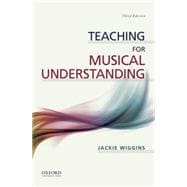Ideal for introductory music education, philosophy and psychology of music education, and music education methods courses, Teaching for Musical Understanding explains current research-based theories of how students learn in order to show prospective and practicing music teachers how to teach effectively. Author Jackie Wiggins draws on her twenty-two years of experience teaching K-12 music and twenty years of teaching in higher education to demonstrate how theory applies to music education. The text is deeply grounded in the work of social constructivist theorists and researchers in both education and music education.
The third edition takes a cultural psychology perspective, giving more attention to sociocultural influences and to the roles of learner agency in learning process. It includes in-depth examples of assessment practices in music classrooms, stories "from the trenches," and more extensive use of endnotes and citations.








